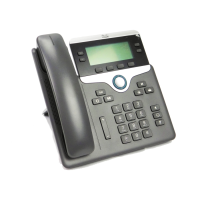The default value of this enterprise parameter is True, which means that all Cisco IP Phone Models that
register to this Cisco Unified Communications Manager advertise G.722 to Cisco Unified Communications
Manager. If each endpoint in the attempted call supports G.722 in the capabilities set, Cisco Unified
Communications Manager chooses that codec for the call whenever possible.
Step 2 To configure wideband support for a specific device:
a) From Cisco Unified Communications Manager Administration, choose Device > Phone.
b) Set the Advertise G.722 and iSAC Codec parameter in the Product Specific Configuration area.
The default value of this product-specific parameter is to use the value that the enterprise parameter
specifies. If you want to override this on a per-phone basis, choose Enabled or Disabled
Headset Management on Older Versions of Cisco Unified Communications
Manager
If you have a version of Cisco Unified Communications Manager older than 12.5(1)SU1, you can remotely
configure your Cisco headset settings for use with on-premises phones.
Remote headset configuration on Cisco Unified Communication Manager version 10.5(2), 11.0(1), 11.5(1),
12.0(1), and 12.5(1) requires you to download a file from the Cisco Software Download website, edit the file,
and then upload the file on the Cisco Unified Communications Manager TFTP server. The file is a JavaScript
Object Notification (JSON) file. The updated headset configuration is applied to the enterprise headsets over
a 10 to 30-minute time frame to prevent a traffic backlog on the TFTP server.
You can manage and configure headsets through Cisco Unified Communications Manager Administration
version 11.5(1)SU7.
Note
Note the following as you work with the JSON file:
• The settings aren't applied if you are missing a bracket or brackets in the code. Use an online tool such
as JSON Formatter and check the format.
• Set the updatedTime setting to the current epoch time or the configuration is not applied. Alternatively,
you can increase the updatedTime value by +1 to make it larger than the previous version.
• Do not change the parameter name or the setting will not be applied.
For more information on the TFTP service, see the "Manage Device Firmware" chapter of the Administration
Guide for Cisco Unified Communications Manager and IM and Presence Service.
Upgrade your phones to the latest firmware release before you apply the defaultheadsetconfig.json
file. The following table describes the default settings you can adjust with the JSON file.
Download the Default Headset Configuration File
Before configuring the headset parameters remotely, you must download the latest JavaScript Object Notation
(JSON) sample file.
Cisco IP Phone 7800 and 8800 Series Accessories Guide for Cisco Unified Communications Manager
30
Headsets
Headset Management on Older Versions of Cisco Unified Communications Manager

